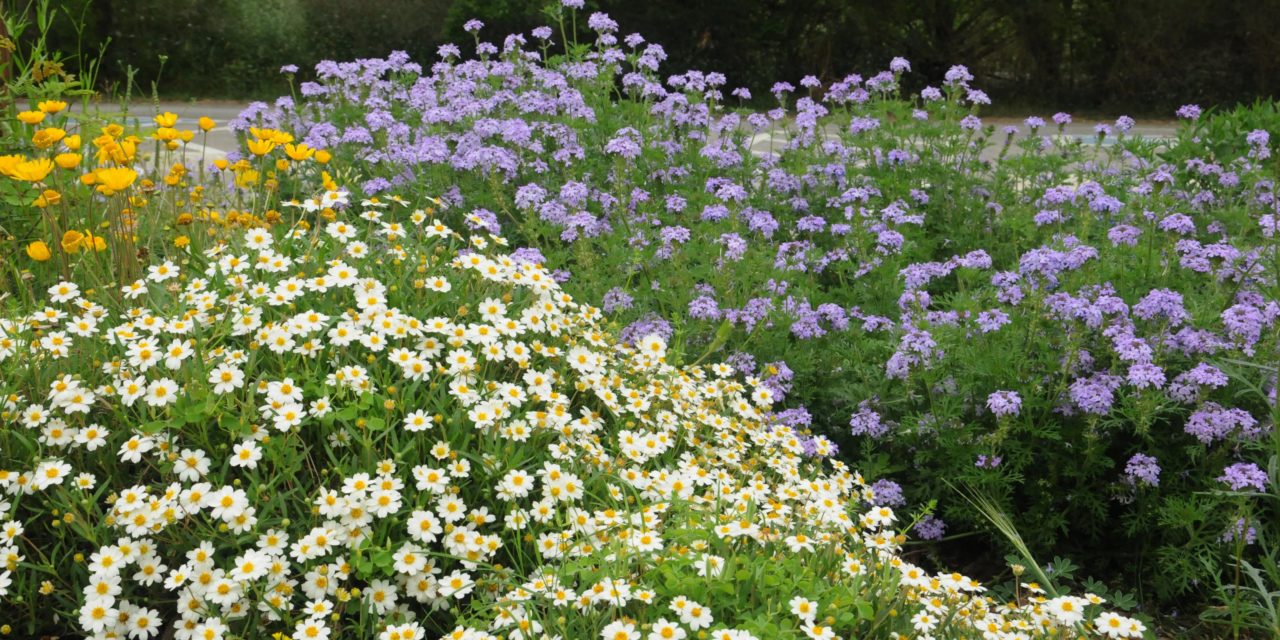By Andrew Awalt
At Large Board Member
Native Plant Society of Texas San Antonio
The Medina River Area provides opportunities for hiking, biking, fishing, picnicking, exploring, and rest for residents in south San Antonio. With the help of a grant from the Native Plant Society of Texas-San Antonio (NPSOT-SA), monarch butterflies and other pollinators will have another area to rest and refresh as well. For the second year, NPSOT-SA provided partial funding for projects in the Medina River Natural Area. The Chaparral Demonstration Garden, funded in 2017, was built and planted last year. The new Monarch Butterfly Meadow is designed to beautify the park, to educate and provide recreation for the public, and provide habitat for wildlife. George Ozuna is a member of NPSOT-SA and co-leader of the Salsa Squad. The Salsa squad is a group whose “mission is to remove toxic and dangerous plants and grasses from nature and work to restore and beautify our environment.” George Ozuna sought the grants in part because “The Medina River Natural Area is the only City of San Antonio natural area located south of the International Airport. The other six natural areas were chosen to serve the city north of the airport. It’s important to highlight the only underserved, underrepresented, underfunded, understaffed, and ignored natural area that serves the rest of the city south of the airport.” The grants help to foster community projects to show the importance of using native plants to improve the environment. Several grant recipients have used the funding to demonstrate support for their project, which helps to get more funding.
In the latest round of grant awards, NPSOT-SA will provide funds to help install a three-acre Monarch Butterfly Meadow in the Medina River Natural Area. The meadow will provide food and breeding areas for the monarch butterflies that travel through South Texas as they migrate to and from their wintering grounds in Mexico. It will also provide a place to show the public and school groups the importance of habitat for the monarch. According to Craig Wilson, a research associate with Texas A&M University, monarch numbers have increased 144% this year. This is due in part to the increase in milkweed in Texas, which is essential to the larval monarchs. The effort depends on the public planting and preserving milkweed stands. The meadow will add host and nectar plants for the monarchs. It will demonstrate plantings that benefit these spectacular insects. The life cycle of the monarch depends on preservation of habitat where they overwinter in Mexico and having food and host plants on the way as they migrate. Texas plays a vital link in this cycle. The site is located on the main east/west trail near the entrance. According to George Ozuna, “The 3.5 acres was mostly invasive weeds and grasses. Thousands of native plants and grasses that are butterfly/pollinator friendly will be established. We hope that the plant seeds spread out into the rest of the natural area.” Site preparation work has begun on the meadow. George Ozuna adds, “We will be building in a trail through the meadow so people can see the beauty of these native species and how it is good for butterflies and other pollinators.” He adds that “The Salsa Squad has prepared the area for months since the beginning of last fall. We have been extensively removing invasive plants and grasses preparing for the seeding in late September.” Anyone wanting to help can join the Salsa Squad by email at gardenarch@yahoo.com. Training is available.
The Chaparral Demonstration Garden at the Medina River Natural Area was funded in part by a NPSOT-SA grant and installed last year. The garden includes brick paths, seating, and a picnic area. It is landscaped with low water-use native plants. It serves as an entrance to the trails and shows how native plants can be used in a home landscape. The landscape was installed by community volunteers from the Native Plant Society, Master Naturalists, Salsa Squad, and the City of San Antonio Parks Department. The plants were watered by City Parks Department crews to get them established, but one year later they live mostly on rainfall. A great thing about native plants is that they are adapted to our area. During drought, they can go dormant and revive and burst into bloom when it rains again. Non-natives will often just die, and need to be replaced. The Demonstration Garden includes orange zexmenia (wedelia acapulcensis var. hispida) https://www.wildflower.org/plants/result.php?id_plant=WEACH, a small blooming shrub. It can survive in the driest conditions in a pasture, but when rains come will bloom from May to November. In a home landscape, where it can be watered occasionally, the orange zexmenia will thrive in the hottest and sunniest part of a landscape. It is a perennial, so it will not have to be replanted each year. As the landscape matures and develops, it will provide beauty and habitat and food for wildlife. Native landscaping uses much less water and becomes a natural part of the environment. The garden replaced invasive Bermuda grass with a beautiful and dynamic landscape.
The NPSOT-SA Monarch Butterfly Meadow and Chaparral demonstration garden are two of several projects that were given grants by the Native Plant Society of Texas- San Antonio. The grants provided seed money, which helped in obtaining more funding. George Ozuna says that “The Alamo Area Master Naturalists were also a major monetary contributor the United States Navy (Salsa Squad Division) and Douglas King Seed were of major assistance.” The City of San Antonio Parks Department provided assistance with installation and maintenance. The Grant Program “seeks to increase San Antonio NPSOT chapter member participation in community projects that promote the use of native plants and the conservation and restoration of native plant habitats through education, outreach, and example. Additionally, the program strives to educate members and the local community about the value and use of native plants and plant habitats. Finally, the program encourages research related to the conservation and restoration of native plants and native plant habitats. Applications are reviewed each year.” See https://npsot.org/wp/sanantonio/grant-program/ for more information on how to apply for a grant.
The NPSOT-SA program is funded by the Bexar Roots plant sale in the fall and spring. The sale provides an opportunity to purchase native plants that are not always available at nurseries, and to advise what will grow best in your yard, no matter how dry, wet, sunny, or shady. The next sale is on Saturday, April 27th, 2019 from 9am to Noon at Phil Hardberger Park East. (13203 Blanco Road) See http://tinyurl.com/BexarRoots for more information.
The Medina River Natural Area has 511 acres with seven miles of trails. The trails wind through the Medina river bottom and are well shaded by large old trees. Visitors can expect to see different plants and animals regardless of the season. George Ozuna says that “The Medina River Natural Area has some of the greatest biodiversity of any of the city natural areas.” The Monarch Butterfly Meadow and the Chaparral Demonstration Gardens will enhance the experience of every visitor, providing a place to appreciate and learn about the natural world. George Ozuna says that “the public can see possibilities this kind of beauty in their own homes, local parks, and open spaces.” The natural areas preserve and highlight how the landscape looked before agriculture and development altered the landscape. As San Antonio grows, preserving these spaces will be more important for us to maintain connection with the natural world. The Medina River Natural Area is located at 15890 Highway 16 South and is open from sunrise to sunset. Please see http://fosana.org/portfolio_page/medina-river-natural-area/ for more information on visiting this unique area.
To get involved with the Native Plant Society, please see: https://npsot.org/wp/sanantonio/ for meetings and programs throughout the year.
Native Plant Society of Texas San Antonio












